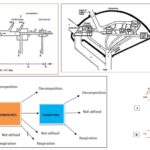Explain the process of inspiration under normal conditions.
Explain the process of inspiration under normal conditions.
Please login to submit an answer.
Inspiration is an active physiological process where air enters the lungs due to pressure changes in the thoracic cavity
Contraction of the diaphragm causes it to flatten and descend, increasing the vertical dimension of the thoracic cavity
Simultaneously, external intercostal muscles elevate the ribs and sternum, expanding the chest cavity in all directions
As the thoracic volume increases, the pleural space expands, becoming more negative in pressure due to adhesive forces and pleural fluid
Typical intrapleural pressure drops from around –5 cmH₂O at rest to about –8 cmH₂O during normal inspiration
This increased negative pressure pulls the lungs outward; volume inside alveoli increases, lowering alveolar (intrapulmonary) pressure below atmospheric pressure
Air flows into the lungs down this pressure gradient until alveolar pressure equals atmospheric pressure and airflow stops
Normal or “quiet” inspiration primarily uses diaphragm and external intercostals; accessory muscles (scalenes, sternocleidomastoid) are recruited only during deep or forceful breaths
Boyle’s law underlies the mechanism: as volume increases, pressure decreases, driving air from high atmospheric pressure into lower pressure alveoli
Neurological control:
The brainstem’s respiratory center (medulla, pons) generates rhythmic nerve signals
These signals travel via the phrenic nerve (to the diaphragm) and intercostal nerves (to intercostals), coordinating muscle contraction
Reflex regulation:
Pulmonary stretch receptors detect lung inflation and inhibit over-inflation via the Hering–Breuer reflex
Summary flow in normal conditions:
Diaphragm and intercostals contract → increase thoracic volume → more negative intrapleural pressure → alveoli expand, reducing alveolar pressure → air flows in → equilibrium reached
- Share on Facebook
- Share on Twitter
- Share on LinkedIn
Helpful: 100%




